Keukenhof - largest park
Many are interested in where in the Land of Tulips is the largest and most picturesque park. Let's answer: this is Keukenhof, located in Lisse. The word "Keukenhof" literally means "kitchen yard".
This flower garden is considered the largest in the world - its area is 32 hectares. Here you can see "rivers" of tulips and "banks" of hyacinths. Keukenhof is also considered a model in the field of landscape design. Every fall, about thirty gardeners begin to create pictures of the coming spring. They plant over 7 million bulbs in this park. The overwhelming majority of growers provide their flowers here free of charge - for each of them is considered a great honor to plant their flower beds in Keukenhof Park. At the same time, flower magnates compete among themselves for the right to receive a diploma for the most beautiful flower and for the most picturesque flower bed. Everyone who has visited the Keukenhof at least once remembers for a lifetime what the Land of Tulips is picturesque and unusual.
Every year tourists can see new landscapes in this park. You can visit it every year, and every time you can be surprised at the skill of the gardeners and organizers. Breeders tirelessly breed more and more new varieties of flowers. Long before the season opens, the organizers are developing a concept for the next exhibition.
In 2012, the main country at the exhibition was Poland. Keukenhof's guests could see a portrait of Chopin made of flowers. And in 2010 the "Russian season" was opened. Here you could see various floral decorations - a hut on chicken legs, a large theater, mittens, nesting dolls. The Cathedral of St. Basil the Blessed was built from flowers, and the main guest was D. Medvedev's wife Svetlana. In the same year, two new varieties of flowers were bred - cream-colored tulips were named Miss Medvedev, and pale pink ones were named Putin. In Keukenhof's gift shops, you can buy your favorite tulip varieties.
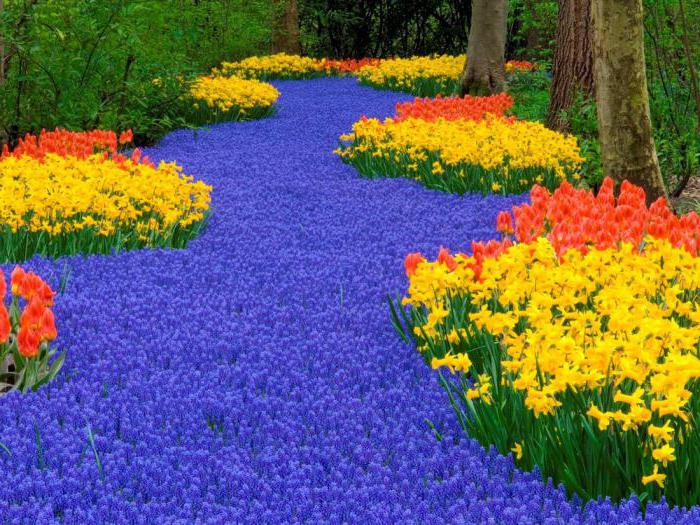
Luxury flower fields to the Netherlands
The state has about 11 thousand hectares of tulip plantations in the world - almost 90% of the world's total. They are scattered throughout the Netherlands - near flower auctions and Keukenhof park. This is due to practical reasons - farmers can quickly deliver their products for sale. The most visited is the tulip field in Lisse - the park is world famous and, moreover, it is the easiest to get there. The fields in the cities of Hillegom and Noordwijkerhout are also loved by tourists. You can get to these points by public transport or by bicycle along a special road - the Flower Way.
Varieties, photo and name of tulips of average flowering time
The second group of plants combines the most common and popular tulips of Darwin and Triumph.
 Included in Class 3, Triumph tulips are a composite group of plants with simple large flowers crowning flower stalks up to 70 cm in height. Varieties dating back to the beginning of the last century and new varieties are excellent for mass cultivation. Growers are attracted by the strong flower stalks of tulips and perfectly shape-retaining flowers, shaped like graceful wine glasses. Flowering begins in the last decade of April and lasts 7-12 days.
Included in Class 3, Triumph tulips are a composite group of plants with simple large flowers crowning flower stalks up to 70 cm in height. Varieties dating back to the beginning of the last century and new varieties are excellent for mass cultivation. Growers are attracted by the strong flower stalks of tulips and perfectly shape-retaining flowers, shaped like graceful wine glasses. Flowering begins in the last decade of April and lasts 7-12 days.
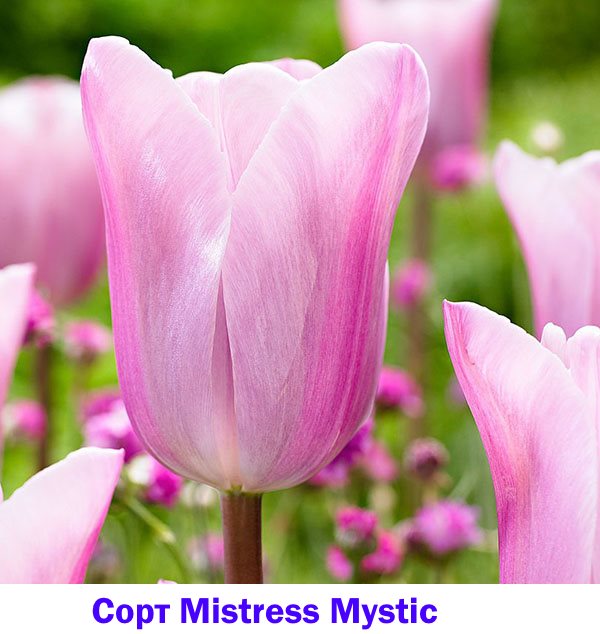 Due to their size, stable flowering and the presence of not only red, but also yellow, pink tulips, plants with white, deep purple and even two-color corollas, mid-early varieties are recognized by landscape designers, ordinary flower growers and those who are partial to tulips in bouquets. The interest of summer residents in the group is supported by:
Due to their size, stable flowering and the presence of not only red, but also yellow, pink tulips, plants with white, deep purple and even two-color corollas, mid-early varieties are recognized by landscape designers, ordinary flower growers and those who are partial to tulips in bouquets. The interest of summer residents in the group is supported by:
- unpretentiousness of varieties;
- versatility of appointment;
- an abundance of colors;
- large flowers that keep their shape and freshness for a long time;
- easy vegetative propagation;
- the ability to use for forcing in the middle and late periods.
Tall, resistant to viral diseases and highly variable due to their tendency to mutation, Darwin's hybrids compete equally with the Triumph tulips and form Class 4, as extensive as the previous one.
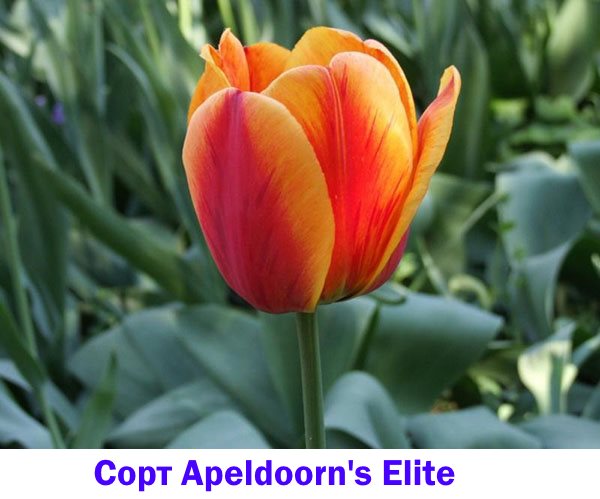 These plants owe their popularity to the tulip variety shown in the photo with the name Apeldoorn, which fully demonstrated the ability to produce offspring during vegetative propagation, unlike the parent plants.
These plants owe their popularity to the tulip variety shown in the photo with the name Apeldoorn, which fully demonstrated the ability to produce offspring during vegetative propagation, unlike the parent plants.
 Another variety widely known in the territory of the former Soviet Union is the Parade tulip, obtained back in the 50s and still decorating the streets of Russian cities and flower beds of summer residents.
Another variety widely known in the territory of the former Soviet Union is the Parade tulip, obtained back in the 50s and still decorating the streets of Russian cities and flower beds of summer residents.
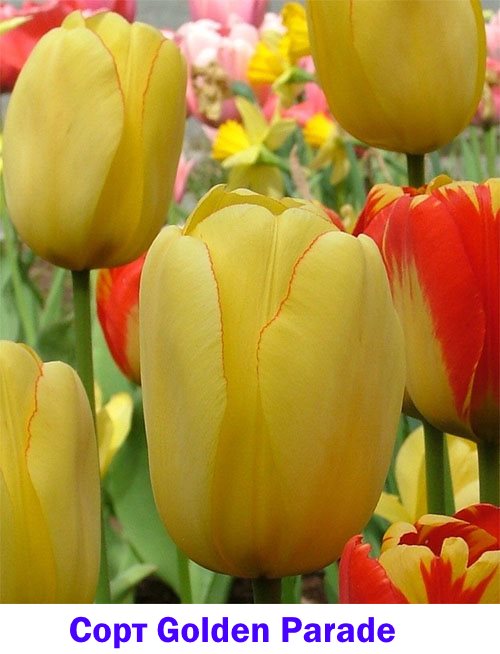 The yellow tulip shown in the photo, closely related to the previous variety, is called Golden Parade and is rightfully considered one of the largest mid-early varieties in the family.
The yellow tulip shown in the photo, closely related to the previous variety, is called Golden Parade and is rightfully considered one of the largest mid-early varieties in the family.
A little about the varieties of tulips
Black tulips have always been considered the most valuable, because this color is very rare for plants. Until now, the Dutch are trying to breed an absolutely black tulip, with each breeder trying to prove that his variety is blacker than others.
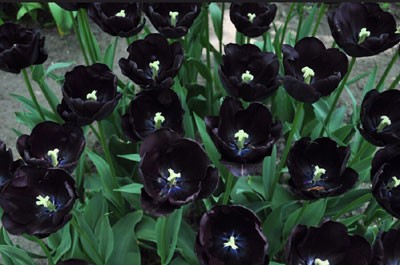
In Holland they love to tell the legend about the poor carpenter and his black tulip. Buyers came to the carpenter who brought out the black tulip. For a long time they begged him to sell the plant, offering decent money. He reluctantly said goodbye to the bulbs. Buyers trampled them right in front of his eyes and said that they themselves bred a black tulip variety, and now they have no competitors. They arrogantly declared that only their variety would go down in history.
Only a variegated tulip could become a variety in Holland, and nowadays such plants are mercilessly dug up and destroyed by breeders. They call this color the result of a viral disease. This color is considered too variegated, so the eye simply has nothing to stop at. Due to the disease, red, yellow and purple tulips become variegated and lose all the characteristics of the variety.
Russian tulips
Not much is known about the history of tulips in Russia. The father of Peter I, Alexei Mikhailovich, grew a small collection of tulips on his estate in Shchelkovo. And Peter himself often brought the bulbs of this plant. Nowadays Vyacheslav Khondarev owns the most numerous collection of tulips, which has found recognition even among Dutch specialists.
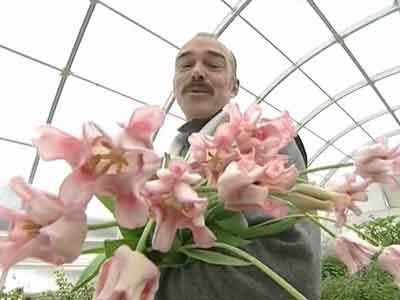
Vyacheslav Khondarev
Some of its author's varieties are registered in the international register. Interestingly, the collection began with a misunderstanding. Vyacheslav's mother every spring dug up and planted a tulip with one leaf in a new place. This went on for several years. She believed that the conditions in the garden were inappropriate, the plant did not bloom, so he needed to find a more favorable place. But tulips need to be replanted in the fall.
Then Vyacheslav decided to help his mother and was so carried away that he could not stop. And is it possible to refuse such beauty at all? There are many varieties of tulips created today. There are fringed, and terry, and even parrot.
If you decide to grow tulips on your site, it is important to remember that they look only in bulk.
Very rarely planted tulips are unlikely to attract attention. Flower beds with a large number of plants look great - from 50 to 70 pieces
The origin of the violet: history and where it comes from
Violet is an annual or perennial herb with a short stem, on which leaves collected in a rosette with strong pubescence are kept. They take the form of an oval, circle or heart. The edge of the leaves is flat or wavy, depending on the type of flower.
Breeders have bred a large number of varieties that differ in flower size and color. For different varieties, the size of the rosette ranges from seven to forty centimeters. The root system of the violet is thin and creeping.
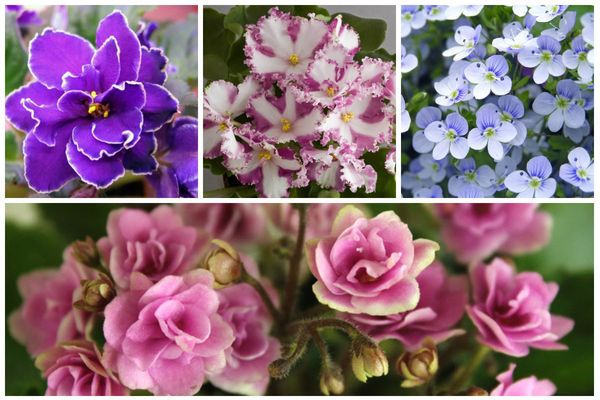 The abundance of violet species is the merit of the breeders
The abundance of violet species is the merit of the breeders
Flowers, double or simple, are collected on pedicels in several pieces. They come in different colors: blue, pink, white, burgundy, blue.
The violet blooms for nine months and does not depend on the season.
The flowers of violets contain anthocyanin glycosides, essential oils. Thanks to these substances, the flowers of the plant are useful in the treatment of eczema, urticaria, and shingles. The violet fruit is a box with valves.
The country is the birthplace of the flower, the nature of the violet
The birthplace of the flower is Africa. It is difficult to name a specific country. The plant grows naturally in temperate weather. Most often it can be found in North America, Japan and the Andes. Some varieties grow in the subtropics of Brazil, tropical and South Africa.
The violet is found on the Australian continent, New Zealand and the Sandwich Islands. Almost all species choose open or slightly shaded areas with a moderately humid climate as their habitat.
Wild violets grow in Europe, in the south of Siberia. Forest ones are found in forest clearings in deciduous forests.
The botanist Hermann Wendland recorded the violet as a separate genus. She received the name Saintpaulia from him in honor of Baron Saint-Paul, who was the president of the German dendrological society. It was he who gave Wendland the seeds of the plant.
In Russian, the violet is called "saintpaulia", freely interpreting the Latin name.
Baron Adalbert Saint-Paul in 1892 discovered a flower in East Africa among the stones while walking with his beloved. He noticed on the stone flowers of blue color with a yellowish center, which are located in a crevice.
The Baron sent the flower to his father Ulrich von Saint-Paul, who collected a collection of rare plants. In 1893, the plant family was identified: Gesneriaceae. In the same year, the violet was shown for the first time at the exhibition. She has been featured in magazines. In Germany, it was called "Uzambara" after the name of the area in Tanzania, where it was found.
The main version of the origin
Today tulips are firmly and indestructible associated with the Netherlands. After all, it is there that most of these flowers are grown. And the quality, their variety amaze the imagination. However, according to most experts, the real homeland of tulips is Kazakhstan. Rather, the south of the Kazakh steppes.
It was there that wild varieties of the flower were found in large quantities. In Western Europe, the decorative tulip began to be grown not earlier than the end of the 16th century. They got there from the Ottoman Empire, where they were cultivated even for the sultans. Most of the tulip varieties developed in Holland were created much later. The Asian varieties were the starting point.
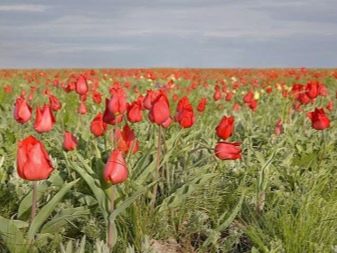

Homeland of tulips
According to another widespread version, the tulip was native to Iran, and it was from there that this flower spread to other Asian countries. Much later, he came to Holland - the Land of Tulips. The word "tulip" comes from the name of the headdress it looks like - "turban".
There is a beautiful legend about this flower. Along one field, where flowers never blossomed, walked a woman with a baby. When the child saw the flowers, he laughed joyfully, and from his happiness they opened up.
So, Carlos Clusius was the person thanks to whom Holland in the future became known as the Land of Tulips. He did not even suspect that he would become the culprit of the sheer insanity of the entire population of this country on tulips. During the Golden Age, this obsession reached a truly unprecedented scale - in order to acquire bulbs of new varieties, the Dutch were ready to give whole fortunes, and for a tulip flower bed they easily said goodbye to rich houses and heirlooms.

What else do you need to know?
According to some professionals, the role of Iran (Persia) in the formation of the tulip is no less than the contribution of Kazakhstan. The fact is that, according to one of the versions, it was there (and not in Turkey) introduced into the culture.The traditional Persian name, Toliban, is given for its resemblance to a turban. In Iran, the tradition of growing this flower is preserved. And even in a number of Tajik cities there is an annual holiday dedicated to him.
Significant selection work has been going on in Turkey for several centuries. A rare Turkish city does not have tulip plantations. And also this flower was placed on the coat of arms of Istanbul in the sultan's times. And in modern Turkey, the tulip pattern is applied to kitchen utensils, houses, decorations and many other items. Each April is accompanied by a dedicated plant festivals.

It is generally accepted that this culture is associated with friendliness, a positive attitude. Starting in the 18th century, the Netherlands took over the palm. Moreover, the export of flowers to Asian countries is already starting from there, and not vice versa. Curiously, the tulip got to Holland and Austria almost at the same time. It is believed that the flower first seen by the Austrians belonged to the Schrenk species.
Although the tulip is native to Asia, the Dutch have mastered it on a large scale. They organize spectacular auctions, which, along with a purely commercial function, have the task of entertaining visitors. A stormy bargaining unfolds as soon as the sun rises. Many auctions are open all year round, but it is still best to come for tulips in the spring or summer. The world's largest commercial tulip flower garden is Keukenhof, located in the city of Lisse.
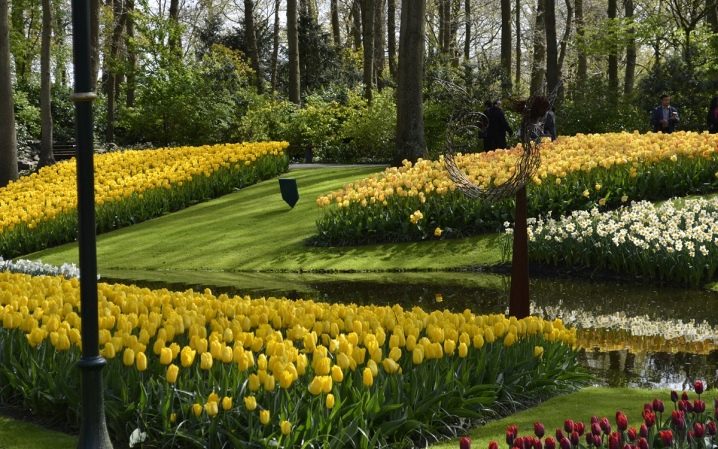
Suppliers generally provide their flowers to the park at no extra cost. The fact is that the very participation in the Keukenhof exposition turns out to be a very honorable right. And the opportunity to promote your products on the market is worth a lot. Every 10 years the international exhibition "Floriada" is held in the Netherlands. And any city in the country is desperately fighting for the right to participate in it.
But back to the past of the tulip. It is assumed that from Turkey it first spread to Greece, Crimea, and the territory of modern Balkan countries. Already from Austria, the flower gets to Italy and Lisbon. At the same time, it spreads across North Africa. And while all this was happening, a real fever unfolded in Holland.
The bulbs cost incredible money. They were hunted. A rare farm in the country has not tried to grow this plant. Those days are long gone, but it is thanks to this feverish activity that Holland is forever ahead of other countries in the field of tulip cultivation.
For more interesting facts about tulips, see the next video.
{SOURCE}
Useful information about the Dutch tulip
It is better to dig up tulips every year so that there are healthy and large bulbs. But if this is not possible, then you can grow them in one place - 3-4 years.
Up to 7 years old, simple varieties with a classic shape and color of flowers can grow.
In this case, you should adhere to certain rules:
- well-lit by the sun and protected from the winds, the location of the flower bed;
- sufficient planting depth, which should be 25 cm;
- provision of nutrients;
- compliance with soil moisture conditions.
How long do tulips live? The tulip is a beautiful eternal plant. The flowers, stem and leaves are annual, and the lifespan of the bulb that is in the ground is 3 years.
During this time, it is gradually depleted and dies, and a replacement bulb and children appear in its place. This cycle is constantly repeated, and with proper care, the plant will delight with its flowering for a very long time.
 Tulip bulbs should be dug up every year
Tulip bulbs should be dug up every year
Flowers with a story: tulip
Spring! On the street there is already a persistent aroma of greenery, waking up from a long hibernation. In some areas, flowers are already in full bloom, delighting those around them with bright petals, somewhere else there is snow, but absolutely everywhere you can feel the imminent arrival of a young beauty in light green silks. Very soon it will warm up the young shoots, and the middle zone of Russia will bloom.
It was the flowers that inspired such a lyrical mood. There are not very many of them in front of the house, but they are common everywhere, so everyone is familiar with them. I will not talk about proper care, but I want to acquaint you with the history and legends that shrouded one of these handsome men.
Specific tulips: the fourth group in the garden classification
The fourth group is the specific tulips used in the selection of cultivated varieties and grown as independent ornamental plants.
 Class 12 is given to Kaufman tulips, which bloom in March, can reach a height of 30 cm, and their flowers with pointed petals of different colors are always organic on low borders and rocky hills.
Class 12 is given to Kaufman tulips, which bloom in March, can reach a height of 30 cm, and their flowers with pointed petals of different colors are always organic on low borders and rocky hills.
Foster's tulips, the tallest of the species, are distinguished not only by this, but also by their large flowers, which made it possible to use the plants to obtain many modern varieties belonging to other groups and classes.
Foster's tulip buds open in April and immediately draw attention to themselves with unusual petals bent at the top.
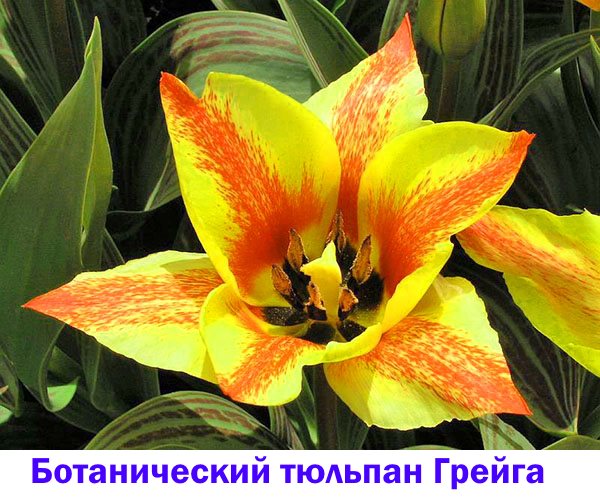 The species Greig tulips and their hybrids forming Class 14 are easily distinguished by their patterned leaves covered with colored stripes and strokes. Although plants of this species are not distinguished by high growth, due to their high decorative effect and long flowering, they are always welcome guests on the site.
The species Greig tulips and their hybrids forming Class 14 are easily distinguished by their patterned leaves covered with colored stripes and strokes. Although plants of this species are not distinguished by high growth, due to their high decorative effect and long flowering, they are always welcome guests on the site.
Class 15 contains wild species tulips. Compared to their garden descendants and relatives, these species, often called botanical, are shorter, better adapted to harsh conditions. In addition, small flowers full of charm are less affected by diseases or completely resistant to them.
Video about tulip varieties
Homeland of tulips - Holland
Homeland of tulips - Holland
It is generally accepted that the homeland of tulips is Holland. However, it is not. Tulips came to the Netherlands in the 16th century from Turkey, after which they took root in it and eventually created the glory of the "country of tulips" in Holland.
By the way, a classic example of a mass delusion is associated with tulips, which is that one can “easily catch a fish from a pond”. In 1634, tulip mania began in Holland. These then exotic flowers became fashionable. Their prices rose rapidly, and the firms growing them flourished. In the mass consciousness, the opinion soon developed that tulips are a way to get rich quick. It is enough to buy more bulbs and then sell them when the price still rises. Very quickly, almost all residents of the Netherlands "plunged headlong" into this "business".
The French psychologist B. Sadis wrote: “The nobles, townspeople, farmers, mechanics, sailors, footmen, maids, chimney sweeps, junk merchants - all got stuck in the tulip trade. Houses and land were sold for ruinously low prices or were used to pay for purchases made in the tulip market. The epidemic was so contagious that foreigners were struck by the same madness, and money flowed to Holland from everywhere. "
For a time, demand exceeded supply. As a result, prices have jumped to unimaginable heights. For example, with the money received for one onion, it was possible to purchase 4 bulls, 12 sheep, 2 cartons of wheat.
It got to the point that people sold all their property for a pittance in order to use the proceeds to buy flowers. Lucky speculators made huge fortunes in one day.
It is not surprising that at one "fine" moment a catastrophe broke out - prices simply collapsed. A hasty sale of flowers began, but no one wanted to take them. Supply exceeded demand and panic began. Thousands of Dutchmen went bankrupt, left without money, but with tulips and huge debts. A familiar picture, isn't it? Until recently, our compatriots in droves carried their "money" to "MMM", "RDS", "Tibet", "Charu" and other one-day firms, and now they are demanding their deposits back. But they themselves are to blame. Nobody forced them to give money. Anyway, a good lesson was learned.But if we knew history better, then maybe the lessons that were received by our ancestors would have been enough. Although this is also nothing more than a delusion. Each generation repeats the same misconceptions that were characteristic of their predecessors.
TSB
the author
Ermishin Oleg
Detailed biological characteristics where it grows
The homeland of the petal plant is Central Asia, where it still grows in natural conditions.
Why is it called that? Named from the Persian word toliban, because the appearance of the buds is similar to an oriental headdress that resembles a turban.
Thanks to artificial cultivation and breeding, there are many types and varieties of this crop, which have different shapes of inflorescences, stem height and flowering period.
What type does it belong to, varieties, families
All varieties are divided into four groups and fifteen classes, consisting of them:
| Group | Class | Name |
| 1 (early flowering) | 1 | simple early |
| 2 | terry early | |
| 2 (medium flowering) | 3 | triumph - tulip |
| 4 | Darwin hybrid | |
| 3 (late flowering) | 5 | simple late |
| 6 | lily | |
| 7 | fringed | |
| 8 | green-colored | |
| 9 | Rembrandt - tulip | |
| 10 | parrot | |
| 11 | terry late | |
| 4 (wild-growing hybrids bred by crossing varieties from the first three groups) |
12 | Kaufman |
| 13 | Foster | |
| 14 | Greig | |
| 15 | other types |
A variety of tulips will allow each grower to choose exactly the variety that suits him in color, size, shape and other parameters.
Description of the plant: fruit, perianth, how many petals, etc.
Describing the plant, it should be noted that the root system of the flower contains annually dying off adventitious roots, placed below on the horseshoe-shaped part of the bottom.
The stem is erect, cylindrical in shape. Depending on the variety, the stem height can be from 15 to 100 cm.
Plants are decorated with large, elongated lanceolate or elongated oval leaves, sometimes with a wavy edge, which are located directly on the stem, closely covering it.
The color depends on the variety of the flower, mainly ranging from a bright green to a bluish shade.
The flower is correct, the perianth has 6 loose leaves and 6 stamens, with elongated anthers. They delight with their beauty and varied color palette.
The fruit is presented in the form of a rounded box, which has a triangular shape, inside which there are seeds.
 The tulip has a straight stem and elongated leaves, 6 stamens, the fruit is a round box with seeds
The tulip has a straight stem and elongated leaves, 6 stamens, the fruit is a round box with seeds
Origin story
Wild geranium was brought to our lands from England in the middle of the 17th century, which is why everyone decided that the foggy coast was the birthplace of an exotic flower - but this is a misconception. Despite its cold hardiness, geranium actually comes from the southern regions - from India and the coast of Africa. It was from there that it was brought to the countries of the Old World, where botanists began to develop new interesting varieties on its basis, including those that are widely used today in garden design and home gardening.
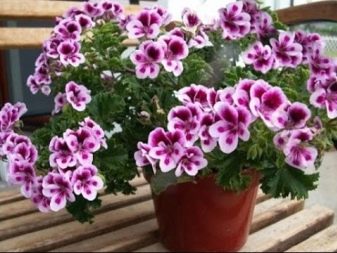

In the historical homeland of the flower, the weather conditions are rather difficult - most of the time the hot scorching sun bakes there, and dry periods are replaced by the seasons of rainfall, which literally flood the earth for long days and even weeks.
In other regions, no more than 15% of geraniums grow, so the culture can be found in Australia and New Zealand, as well as on Madagascar and the California coast of America.
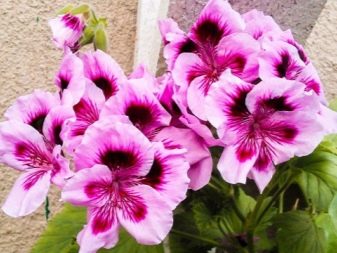
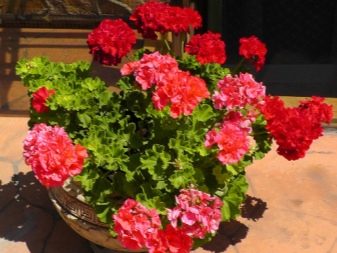
As soon as geranium was first brought to Europe, nobles immediately began to use it to decorate windows in their palaces, and ladies plucked inflorescences to decorate hairstyles, hats and necklines. Due to its unpretentiousness and ease of reproduction, this beautiful plant soon migrated to the homes of ordinary people.
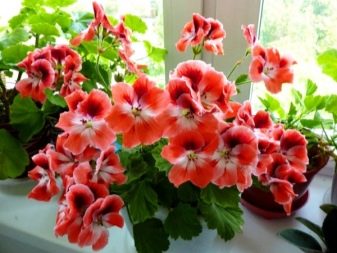

But back to the beginning of the story. As we have already mentioned, this culture originally grew in the southern part of the African continent.At that time, sailors and travelers sailed the seas and oceans, discovering new lands. Often they were only interested in the culture and features of the infrastructure of the territories where they sailed. But many expeditions aimed to study the flora and fauna characteristic of a particular area - that is why such an exotic flower as geranium simply could not remain unnoticed by them.
Botanists immediately turned their attention to the exceptional beauty of the inflorescence, and they immediately had a great desire to adapt this culture for growth and development in other weather conditions. This is how geranium began to spread throughout the globe, gradually adapting to the most diverse and sometimes difficult climate in which it found itself
Today it is one of the most cold-resistant flower crops, so many find it so surprising that she was born in hot countries.


The flower reached Russia only at the turn of the 18th and 19th centuries.
Scientists-breeders did not pass by geraniums, who began to develop the most interesting decorative flowering varieties of the variety on its basis. Each of the plants obtained differs in its shape, color palette and size, but in any case, each of them invariably pleases the eye and effectively decorates any area wherever it turns out.
It should be noted that not all types of geraniums were tamed by humans, many of its varieties remained to grow in the wild, gradually spreading through forests and meadows, populating marshy and steppe regions - they staunchly fought against natural factors unfavorable for them, became stronger and stronger ...

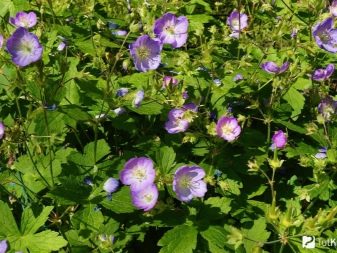
Floriada
But Keukenhof is only open for 9 weeks. Although it is the largest park, there is a project in the Land of Tulips that surpasses the Keukenhof in scale. This is the world famous horticultural exhibition that takes place in Holland only once a decade - "Floriada".
Various cities in the Netherlands are constantly fighting for the right to host this famous exhibition. The city of Almere is a candidate for the next Floriada, which will take place in 2022. The exhibition area is about 66 hectares. Usually, there are not only picturesque flower beds, but also various pavilions, cinemas, recreation areas and attractions.


